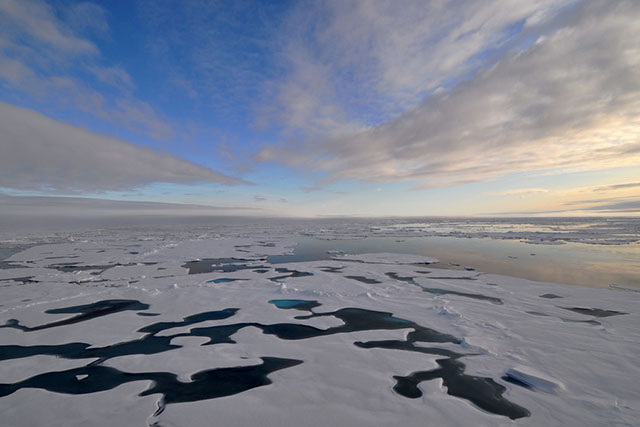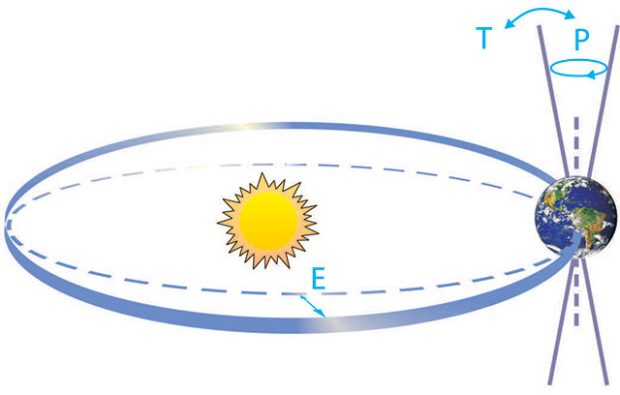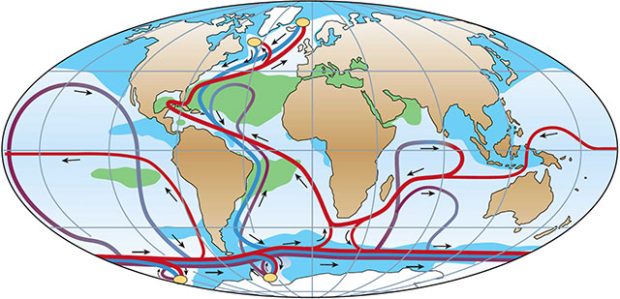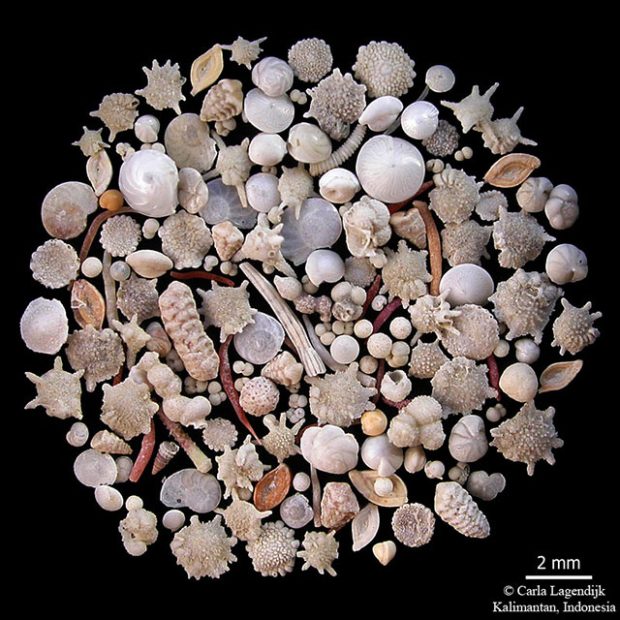Glaciology and Climate Change
Glaciologist Martin Siegert on the history of glacial theory, lake Vostok research and what ice tells us about...

Palaeontology studies the ancient organic world, reconstructing both its development and the laws governing it over time and space. One of the primary goals of palaeontology is to recreate the environmental conditions of different periods in Earth’s history based on the remains of ancient organisms. One of the most critical aspects of the environment is climate. Climate regulates the conditions under which living organisms exist and influences the formation of certain types of natural resources and sedimentary rocks.
Tracing historical climate changes is the main objective, as it uncovers patterns and cycles in the planet’s history. Along with studying the configuration of continents, the distribution of land and sea, topographical features, and determining paleotemperatures, this information allows scientists to carry out paleogeographic reconstructions and recreate ancient climates.
In these studies, the principle of actualism is employed, which posits that natural processes in the past followed the same laws as they do today. For example, if we discover a colony of fossilised corals, we can infer that this area once had warm, salty waters at a depth of up to 50 meters where sunlight could penetrate. Numerous coral colonies spread over a large area can be grouped into regions with uniform climate conditions. By combining similar finds from different locations, researchers can define areas with the same environmental conditions during a specific geological period. This is the basic idea behind paleobiogeographic zoning.
An interesting fact is that a scientist studying climate was responsible for a groundbreaking theory on the development of the Earth’s crust. In the early 20th century, meteorologist and geologist Alfred Wegener, using similarities in paleoclimatic conditions, geological structures, and continental outlines, proposed the first theory of continental drift. This theory later became the foundation for modern plate tectonics.
Today’s understanding of climate formation is known as the orbital theory, as it relates to changes in Earth’s orbital parameters, such as eccentricity (E, the degree of elongation of Earth’s elliptical orbit), axial tilt (T), and precession (P, the change in the direction of Earth’s axis relative to the central axis of the orbital ellipse). These parameters determine the amount of solar radiation (insolation) the Earth receives. Atmospheric and oceanic processes also play a crucial role in redistributing heat across the planet, often amplifying the effects of insolation variations through what is known as positive feedback loops.

The ocean is a key agent in this heat redistribution. The modern concept of global ocean circulation, proposed in the 1990s, is based on the movement of water masses driven by density differences caused by uneven temperature and salinity distributions. This process is known as the global thermohaline circulation. As water moves, its properties, such as oxygen content and various chemical elements, also change. For this reason, this system is called the global ocean conveyor belt. In illustrations, surface currents are typically shown in red, deep currents in blue and bottom currents in purple.
Scientists are mainly focused on the North Atlantic and Southern Ocean, where there are four regions with sharp changes in water properties—known as convection cells—where surface waters plunge into the depths. These key regions are of particular interest for studying past climate changes.

The circulation patterns that we see today began to take shape during the Paleogene period, primarily due to the continental drift when South America and Australia started separating from Antarctica. This led to the division of warm equatorial and cold Antarctic currents, strengthening latitudinal zonality. The formation of the circumpolar current and the Southern Ocean connected the Atlantic, Indian, and Pacific Oceans into a single system. From then on, the poles began to cool, and ice caps formed. By the Eocene, around 47–46 million years ago, sea ice began appearing in the Arctic. Over time, the ice cover expanded, and around the boundary between the Eocene and Oligocene, approximately 34 million years ago, significant glaciation occurred in Greenland and Antarctica.
As the modern landscape evolved—marked by the uplift of the Tibetan Plateau, the formation of the Isthmus of Panama, the closing of the Tethys Ocean, and the creation of the Mediterranean Sea, as well as the narrowing of the Indonesian passage—thermohaline circulation as we know it today became established around 2.7 million years ago. This triggered a general climate cooling, with the growth of glaciers and sea ice. The period from 2.6 million years ago to the present is often called the Pleistocene Ice Age, characterized by alternating glacial and interglacial periods. Changes in orbital parameters and their feedback mechanisms influenced the heat transfer rate by the ocean conveyor, leading to shifts between cold and warm epochs.
Over the last million years, a 100,000-year cycle has been observed in alternating glacial periods, with approximately 90,000 years of glaciation followed by 10,000 years of interglacial conditions. In paleoclimate records, shorter cycles can also be detected, some as brief as seasonal variations. The more detailed the examination of the geological record, the more accurately short-term climate events can be identified.
What records of past climates can we study? These include geological deposits on land (such as moraines, the most well-known glacial deposits), marine sediments, and glaciers. Marine sediments are studied by geologists, who use specialized equipment like piston corers, grab samplers, multicores, and drilling rigs to retrieve ocean floor samples.
Ice cores from Antarctica and Greenland are considered some of the most informative sources, offering detailed records of millennia of climate events. Scientists can track atmospheric changes by analysing the ice’s chemical composition. For example, the uninterrupted ice core sequence from Greenland’s NGRIP is used as the standard for defining the lower boundary of the Holocene epoch on a geochronological scale.
In addition to studying the lithological composition of rock deposits, the remains of organisms that lived during those periods—from mammoths to microscopic protozoa—provide important environmental information. Geochemical analyses of both minerals and organism shells allow for the quantitative assessment of various parameters, such as paleotemperatures.
Today, comprehensive studies of the geological record, combining lithology, geochemistry, palaeontology, and other fields, are a research priority in reconstructing Earth’s climate history.

The use of multiple methods simultaneously provides a more complete picture of paleoclimate. These methods complement each other and allow researchers to cross-check their results. One of the most important tools in analytical studies is the microscope. A comprehensive lithological analysis examines the material composition of sediments, helping to determine the origin of rocks, identify source materials, and compare (correlate) sediments from different regions.
Higher plants and algae serve as direct witnesses to climate change. Dendrochronology, the study of tree rings, reveals information about seasonal cycles. The palynological method, which analyzes plant spores and pollen, is widely used in stratigraphy to determine the relative age of rocks. Paleosol (ancient soil) analysis is crucial in studying ancient landscapes. Analyzing diatom complexes (algae covered in silica shells) found in freshwater and marine environments helps solve many paleoclimate questions. Diatoms are a significant part of primary production in temperate and polar latitudes. Researchers also study cysts of other algae groups, such as dinoflagellates.
Among animal remains, the most valuable for paleogeographic and paleoclimatic reconstructions are those of tiny organisms, as they are more likely to be preserved in the geological record. Among vertebrates, bones of small mammals, particularly teeth, are the most common. Invertebrates, especially molluscs—both bivalves and gastropods (with spiral shells)—are widespread and highly diverse. Due to their biological characteristics, differing rates of evolutionary development, and varied responses to environmental changes, nearly every species provides insights into specific ecological conditions.
An essential method in paleoclimate research is micropaleontology. Studying microfauna from seas and oceans addresses paleoecological questions and provides material for geochemical research and dating of sediments. Popular groups for study among microscopic organisms include foraminifera, radiolarians, and ostracods (tiny-shelled crustaceans). Planktonic organisms, which live at different depths in the water column, and benthic organisms, which dwell on the seafloor, provide valuable information about water masses and currents—from surface to deep waters.
The geochemistry of stable isotopes (especially oxygen, carbon, and hydrogen) is widely used in palaeoclimatology and palaeogeography. The oxygen isotope method is one of the most common and allows for comparisons between marine and continental sediments. This technique, known as oxygen isotope stratigraphy, provides a continuous record of changes in the ratio of oxygen isotopes (δ18O, ‰), which clearly shows fluctuations in ice volume on continents and temperature, reflecting glacial and interglacial stages as well as other regional events. The resulting sequence is compared with reference curves to determine the stratigraphic position of a studied interval in global geological history. One such reference, the marine oxygen isotope curve, synthesises 57 oxygen isotope records from benthic foraminifera shells collected from different parts of the world’s oceans.
Climate change is a pressing issue today, with widespread discussions about global warming due to observations of rising average temperatures over the past century, increasing sea levels, and higher concentrations of greenhouse gases. Understanding this problem and modeling future climate scenarios can be greatly aided by studying paleoclimate dynamics in the geological record, as the past often holds the key to understanding the present.
The most recent geological period, known as the Quaternary (beginning 2.6 million years ago), is particularly suitable for studying paleoclimate and reconstructing recent events. For this time frame, current methods for determining the absolute age of rocks are highly effective. Quaternary geology addresses many questions related to the history of climate change by studying land and marine sediment layers, glaciers, and ice cores. Scientists also seek analogues in the past that may resemble today’s climate development.
Theories developed from paleoclimate research are tested by creating climate models calculated using numerous environmental parameters on supercomputers. The more variables can be incorporated into the model, the more reliable it becomes. These models are then used to forecast future climate trends. The more detailed our understanding of past climates, the better we can identify patterns and predict the future climate.

Glaciologist Martin Siegert on the history of glacial theory, lake Vostok research and what ice tells us about...

Physicist Joanna Haigh on natural temperature records, ocean circulation, and global warming

Geographer Anson Mackay on the ecosystem services, the demands on freshwater around the Earth and the decline ...